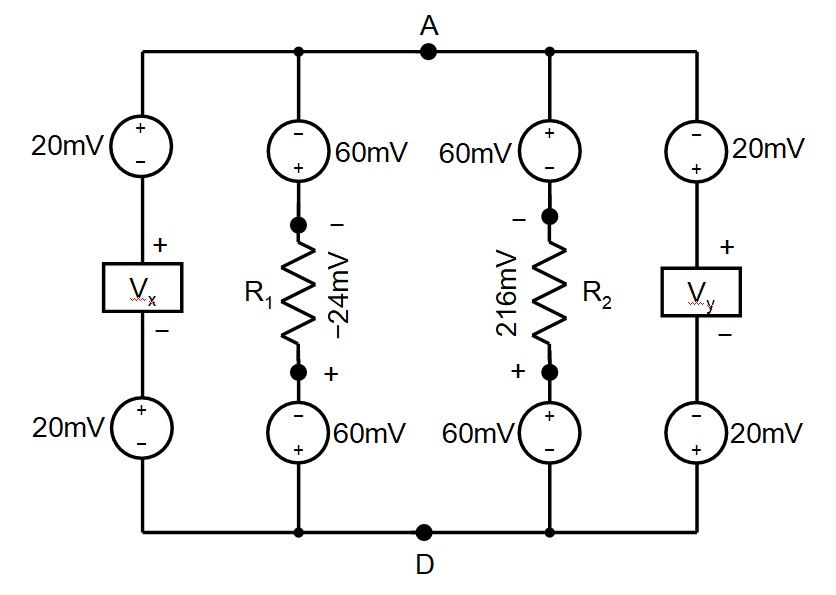It's like trying to explain color to someone who is blind since birth.
I have already calculated "VAD" twice: its value depends on the path.
On the path set by the first voltmeter I get -136mV; on the path set by the second voltmeter I get -56mV.
I can compute on any path I want, if I know how the dB/dt region is partitioned by the path itself. Do you have any idea how easy it is for me to compute it? The only difficulty is making sure I am following that spiral labyrinth you set up hoping to get us confused.
Now, I solved your challenge.
Will you solve a few very elementary problems I pose? Or will you evade my questions as Jesse Gordon is doing?
You have solve nothing! For a moment I thought you knew how to solve circuits, but then you come with such a ridiculous argument. Do you even know what a 'node' is? Of course I was expecting you to come with some sort of excuse, but this is plainly denial! I see now that trying to reason with you is impossible. For everyone else reading, I'll now show how to get the solution, and how simple it is to compute the voltage between the nodes A and D, V
AD, a process that was not done correctly in Lewin's presentation.
In the problem I posted above the total generated EMF is 240mV. Using KVL we now compute the loop current as:
\$
I = \frac{{EMF}}{{R_1 + R_2 }} = \frac{{240mV}}{{100\Omega + 900\Omega }} = 0.240mA
\$
Now we can compute the voltage drop in each resistor:
\$
\begin{array}{l}
V_2 = R_2 \cdot I = 900\Omega \cdot 0.240mA = 216mV \\
V_1 = - R_1 \cdot I = - 100\Omega \cdot 0.240mA = - 24mV \\
\end{array}
\$
To solve for V
x and V
y we need to find an equivalent circuit to work with. We know that three wire loops are generating 240mV. So each quarter of a loop can be lumped as a voltage source of 240mV/(3*4)=20mV. We now notice that the '+' terminal of R
1 is 3/4 loop (or a 60mV voltage source) from node 'D' and the '-' terminal of R
1 is also 3/4 loop (or a 60mV voltage source) from node 'A'. Similarly the V
x 'voltmeter' is 1/4 loop (or a 20mV voltage source) from node 'A' and 1/4 loop (or a 20mV voltage source) from node 'D'. The same can be said to R
2 and the V
y 'voltmeter'. Being very careful with the signs, this is the equivalent circuit we need:

To solve for V
x, we apply KVL to the left loop:
\$
V_x = - 20mV - 60mV - ( - 24mV) - 60mV - 20mV = - 136mV
\$
To solve for V
y, we apply KVL to the right loop:
\$
V_y = 20mV + 60mV - 216mV + 60mV + 20mV = - 56mV
\$
Finally, to find V
AD, we can calculate it in four different ways from the equivalent circuit above by applying KVL to each one of the four branches between nodes A and D:
\[
\begin{array}{l}
V_{AD} = 20mV + ( - 136mV) + 20mV = - 96mV \\
V_{AD} = - 60mV - ( - 24mV) - 60mV = - 96mV \\
V_{AD} = 60mV - 216mV + 60mV = - 96mV \\
V_{AD} = - 20mV + ( - 56mV) - 20mV = - 96mV \\
\end{array}
\]
So how many values we have for VAD? Just one: -96mV.I assembled and tested this circuit. The voltages I measured are V
1=-24.4mV, V
2=212mV, V
x=-134mV, V
y=-56mV, and V
AD=-96mV, as shown in the attached oscilloscope captured images.
As you can see, the theory and the measurements are a very good match!I know, I know: Almost a perfect match from theoretical computations and experimental results mean nothing for team Lewin. For everyone else, here is the evidence, once again, that KVL works perfectly for circuits under the influence of varying external magnetic fields and that Lewin did NOT get his calculations correct in his presentation because he ignored the induced voltages in the wires when he extracted the equivalent circuit.